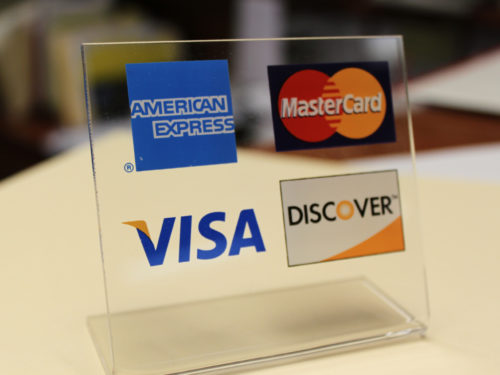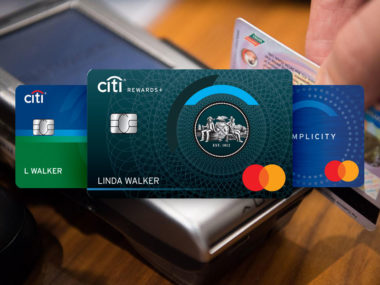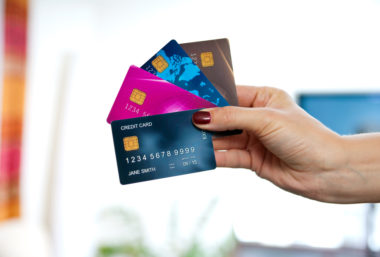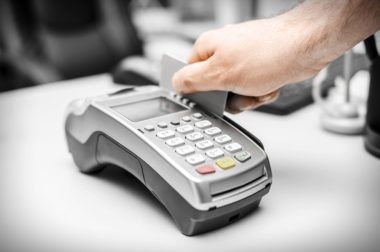In our minds, credit cards work much like our cell phones. We all have a different network (Verizon, AT&T, Sprint, etc), and we all have different models (Apple, Samsung, Google, etc), but as long as the phone works for us, then we’re not complaining.
But when you’re shopping around for your first cellphone, you have to do your research. The same goes for your credit card. Although your first credit card might just be the one your bank offers, or something tied to your favorite retailer, you still need to do some research on what card will work best for you. Maybe you’re even shopping around for your first business credit card. How do you choose between the four main card companies?
Here’s some information on what each card network offers, and how it might best fit your personal wallet or your business wallet.
Table of Contents
Credit Card Networks: The Big Four
Before diving in, it’s important to understand the terminology commonly used around cards. Just as described above with the cellphone analogy, there is the network and the issuer.
The network is the card type: Visa, Mastercard, Discover, or American Express (Amex). These are also known as the payment processors. Unlike the issuer, they assume no credit risk, and perform no credit reporting about the consumer using their cards. Networks are simply a conduit to get the money from the bank (issuer) to the merchant (coffee shop, store, retail outlet, etc).
Which Credit Card Company is Oldest?
Visa and Mastercard are the two oldest credit card networks, but American Express has existed as a bank since the mid-1800s. Amex joined the credit card industry after Visa and Mastercard, but catered to high-spending individuals. Discover joined the credit card game in the 1980’s, offering special rewards and low-fees to consumers that were frustrated with the other options. In many ways, Discover invented credit card rewards as we know them today.
It’s important to note that each of these four networks are all competitors. So, it is wrong to ask what brand a card is: such as “Is American Express a Visa or a Mastercard?” because it is its own network. Similarly, asking what kind of company Visa is has a simple answer: it is a credit card network, not a company like Target or Costco.
However, it can also get tricky, as some networks can also work as issuers. For example, American Express and Discover are both banks (issuers) and credit card networks. They have the ability to function as both, and thus can pose an impact on your credit score.
Credit Card Issuers: How They Differ From a Network
The issuer is the bank (or entity) that is loaning you the money and extending credit. These banks can be anywhere from regular, run-of-the-mill banks like J.P. Morgan Chase or Wells Fargo, to smaller banks that only deal with credit card issuing: such as Capital One or American Express.
This is how issuers and networks can get a bit confusing. However, the issuer is really doing all the work behind your credit card. They are reporting your payments to the credit bureaus, receiving your monthly bill payments, and assuming all the risk when it comes to security and letting you accumulate debt. Visa, Mastercard, and the other networks will only ensure that the money gets from the issuing bank to the merchant. They provide the infrastructure, while issuers provide the capital for credit card transactions.
Retailers and In-Store Credit Cards
Sometimes these issuers are hidden, as is often the case with many retail or sponsored cards. For example, you may see a Cabela’s Visa Card, but which company is the bank? The bank is actually Capital One, but you won’t know that unless you sign up for the card and sign an agreement (or do your research online). The Cabela’s part (or the part of the retailer or sponsor) is known as an “affinity” group. They offer targeted rewards for repeat customers, but the primary goal of affinity groups is branding and advertising, not providing lines of credit. This also works for airline mileage cards, which collect airline miles from the affinity group every time you use the card.
Differences Between Visa, Mastercard, Discover, and American Express
American Express and Discover are unique compared to Visa and Mastercard. This is because Amex and Discover can act as both a network and an issuer; they are a bank and a credit card company. Sometimes they will have an affinity or partnership with another entity (for example, Costco’s credit card was partnered with Amex until 2016), but for the most part they function by themselves. In more recent years, Amex has partnered with certain banks to act as a network for them, while the bank acts as the issuer.
However, when comparing the history and ratings of all four major networks, there are some distinct differences between them all. Some have historically high annual rates, while others are more widely accepted by merchants around the world.
Visa and Mastercard Have the Biggest Networks
Visa and Mastercard premiered the first credit cards in 1966, by branching off from Bank of America (Visa) and InterBank Card Association (Mastercard) respectively. Over time, they have also become the most popular options available.
According to a WalletHub study from 2016, Visa and Mastercard are both accepted by over 8 million merchants within the United States, and are accepted in over 200 countries around the world (210+ in Mastercard’s case). Their fraud protection is labeled as “Good” in this study, which shows some room for improvement.
Visa makes up approximately 48.8 percent of all credit cards used in the United States, making it the most widely used credit card network. Mastercard makes up about 31.3 percent. Visa is obviously a popular option, and their age as a company might have a lot to do with that. However, they do also offer guaranteed payment for merchants (meaning if you charge your card, but don’t have the funds, the merchant will still be paid; you will just have a nasty fee waiting for you on your next bill). Visa’s popularity might also stem from their variety of options available to customers: debit cards, credit cards, or prepaid and secured credit card services.
Mastercard, on the other hand, offers only debit and credit services for their issuing partners. They do not offer additional services such as guaranteed payment, and their sole purpose as a company is to act as the conduit from bank to merchant.
American Express
The American Express (Amex) company has actually been around an as American-based bank since 1850, and has been offering charge cards to customers since the mid-twentieth century. However, their old system was specific to traveling and high-priced entertainment, and required any balances to be paid in full by the end of the month. Although some of the terms have changed, much of their modern-day marketing is still aimed at the big-spenders and they are traditionally seen as a rich-man’s card company (some of the annual fees can get a bit pricey).
A lot has changed for Amex since those earlier years, and they are now a leader in the credit card industry, functioning as both a network and issuer. They — like Discover — only service a fraction of the industry, but they are certainly an influential card company. According to the 2016 WalletHub Study, Amex is the smallest credit card network as they make up about 9.2 percent of cards issued, are accepted by 4.5 million merchants in the US, and are accepted in 160+ countries. They also have an “Excellent” rating for credit card fraud prevention. To this day, they are a highly regarded company, and have a record of superb customer service.
One of the biggest issues that is brought up around the Amex name is their high swipe fee charges for merchants (not consumers). This turns off many small business owners and retailers to the service.
However, to curb this attitude, Amex began the Small Business Saturday tradition in an attempt to win favor from small businesses and their customers, as well as to support the network of small businesses throughout America. Small Business Saturday is held the Saturday after Thanksgiving, as a direct action against the ever-growing Black Friday (which traditionally only supports box stores and corporations). This is only an example of the effort American Express puts into supporting both merchants and customers and building a community around their brand.
Discover
Discover is only accepted by a fraction of the network that Visa and Mastercard have: 7 million merchants in the US, and only 49 countries. They make up about 10.7 percent of cards issued in America. However, where they shine is in their fraud protection, which is labeled as “Excellent” by the WalletHub Study from 2016.
Despite their relative lack of support from merchants, Discover offers some amazing benefits to card holders (you). In fact, their perks are exactly what they’ve built the business around. In the mid-1980’s, when they were a branch of the Sears corp., Discover commercials advertised the new credit card business as the only one that would offer benefits for the customers. Cash back rewards, no annual fees, and more drew in the attention of many people who were fed up with paying for their credit cards, which was typical at the time.
Since the early days, Discover has eventually become their own entity, separating from Morgan Stanley in 2007, and buying up Pulse in 2005 to build their network. They now offer debit services alongside their credit options.
What Are Merchant Fees?
Credit card networks (the big four) make money by charging a “swipe fee” to the merchant in exchange for processing the transaction. This merchant fee is what turn many businesses off to accepting credit cards from specific networks.
Some merchants, such as at small farmer’s markets or small businesses in rural towns, will reject credit cards entirely because they cannot afford to pay flat-rate merchant fees for small purchases. However, advances with mobile devices — such as with the Square credit card reader, which offers merchant agreements with small businesses in exchange for processing cards — have allowed many merchants to sell items while working remotely and has also given them a competitive advantage with other sellers. Accepting credit cards can often make or break a sale in our modern economy, and with devices like Square and others, merchants don’t have to worry about astronomical fees: only a small percentage of their sales will go to the swiping service they are using (2.75 percent or less, traditionally).
Debit Card Networks
Now, you may have noticed your debit card also has a Visa or Mastercard logo on it. How do these debit cards differ from credit cards, other than where your money is coming from? As it turns out, the difference might not be noticeable to you, but it makes a major impact on the merchant.
The Difference Between Debit and Credit Cards
Traditionally, debit cards will be processed through a series of special PIN-based networks: Star, Nyce, Maestro, and Pulse are a few of them. The reason they have a credit card logo on them is because they can also be processed through that specific network if the merchant only has access to a credit card network. Some merchants will have both a debit or credit card option when you’re purchasing an item (this is the “sign” or “PIN” option when you’re checking out).
However, some merchants will have agreements that charge too much for debit transactions, and so they will opt to only use credit card networks to help them save money. The consumer’s money is always coming from the same place (your bank account if you’re using a debit card, or the issuer if you’re using a credit card), but the network that it runs through will be dependent on what the merchant’s agreement with the networks. So it won’t affect you directly, and won’t cost you any differently to run through either the debit or credit network.
Which Credit Card is the Best?
When it comes down to finding the right card, the search isn’t as simple as right and wrong. There are many cards that may cater to your needs, but ultimately the decision is in your hands to make the final choice. Weigh the options when it comes to annual fees, rewards, and additional perks like air miles or store discounts. Now that you understand the difference between networks and issuers, you can shop around for which network of card and issuer fits your needs.
Visa and Mastercard may have a hold on the market — and certainly their network of accepted merchants is a high selling point for many people — but Discover and Amex have a history of providing superb customer perks and services. You will have to decide what is right for you: customer service, or the places you can use the card? Are you traditionally a big spender, or are you looking to use the card on everyday small expenses?
Visa, Mastercard, Discover, or Amex; who will win the credit card wars and earn a place in your wallet?
Looking for more information, tips, and guides on credit cards? Check out our credit card resource and learning center. Want to know more about the “credit” part in credit card? Visit our credit score resource center.
Image source: https://www.flickr.com/





